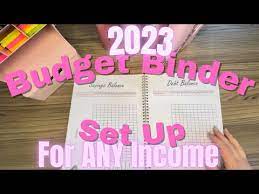Feeling overwhelmed by your finances? Drowning in bills and unsure where your money goes each month? Fear not, friend! The solution lies not in intricate financial apps or hefty budgeting software, but in a simple, yet powerful tool: the budget binder.
Let’s face it, traditional budgeting methods can be intimidating and complex. But a budget binder offers a tangible, accessible way to take control of your finances. It’s like a personal financial command center, where you can track your income, expenses, and goals, all in one convenient place.
Here’s why a budget binder is the perfect solution for beginners:
- Simplicity: No need for technological expertise or fancy software. Just pen and paper (or printable templates) and you’re good to go!
- Customization: You can tailor your binder to your specific needs and spending habits.
- Visualization: Seeing your finances laid out visually can be incredibly motivating and help you identify spending patterns.
- Accessibility: Your binder is always with you, ready for updates and quick financial checks.
But where do you start? Don’t worry, this guide will equip you with everything you need to know about creating and utilizing your very own budget binder.
Setting Up Your Budget Binder:
- Gather your materials: Choose a binder that suits your style and needs. Consider size, color, and functionality. You’ll also need paper, pens, dividers, and any additional supplies you desire.
- Divide and conquer: Create sections for each major category of your budget, such as income, bills, groceries, dining, etc. Label each section clearly with dividers for easy navigation.
- Income trackers: Dedicate a section to tracking your monthly income from all sources. Include pay stubs, bank statements, and any other income documentation.
- Expense trackers: This is where the magic happens! Create individual pages for each expense category. Use simple tables or pre-made templates to record your daily, weekly, or monthly spending.
- Cash envelopes (optional): Enhance your budgeting experience by incorporating cash envelopes for each spending category. This can be a powerful tool for limiting impulsive spending and staying within your budget.
- Goals and motivation: Dedicate a section to your financial goals. Write down your short- and long-term aspirations, and create a plan to achieve them. This section will serve as constant motivation on your budgeting journey.
Tips and Tricks for Newbies:
- Start small: Begin by tracking just a few categories. As you get comfortable, gradually add more.
- Be honest: Track all your expenses, even the small ones. Honesty is key to gaining a clear picture of your financial situation.
- Review regularly: Set aside time each week or month to review your spending and update your records. This will help you identify areas where you can cut back and adjust your budget accordingly.
- Celebrate wins: Acknowledge your achievements, no matter how small. This will keep you motivated and on track to reaching your financial goals.
Remember, a budget binder is not just a tool; it’s a commitment to your financial well-being. By consistently tracking your income and expenses, you’ll gain valuable insights into your spending habits and empower yourself to make informed financial decisions.
Take the first step towards financial freedom today. Grab a binder, unleash your creativity, and start building your personal finance command center!
FAQs:
1. What if I don’t like to write things down?
No problem! Many online resources offer printable budget binder templates and digital budgeting apps that can be just as effective.
2. How often should I update my budget binder?
It’s ideal to update your income and expenses at least once a week. You can also schedule monthly reviews to analyze your spending trends and make adjustments as needed.
3. What if I make mistakes?
Don’t worry, mistakes are part of the learning process. Simply correct any errors and move forward. Consistency is key!
4. Can I use a budget binder with other budgeting methods?
Absolutely! The beauty of the budget binder is its versatility. You can combine it with budgeting apps, online tools, or any other method that works best for you.
5. Where can I find budget binder templates and resources?
A quick online search will reveal a wealth of resources, including printable templates, budgeting tutorials, and helpful blogs.
